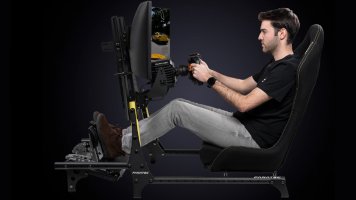I'd like to start a thread showing the components of a tactile upgrade I recently made to my rig. I guess I would have done things in the wrong way and/or not have thought of important stuff at all without all the info shared by the usual suspects in this forum.
The idea of this post(s) is to share my upgrades with others in as much detail as possible. Not because I think the upgrades are the best possible but to make them clearly visible. On the other hand this will take some time so I plan to do this in multiple posts until all aspects are covered.
In general the upgrade is by far not as sophisticated as others have done it - but it can serve as a few ideas how to achieve good results (very good actually ) from my specific starting points.
) from my specific starting points.


First off, here are before/after photos of the rig. Obvious differences are:
- The rig is now based on a platform
- Pedal area is modified
- There is some strange construction behind the seat
I'll get to those three things in the posts to come (hopefully over the next 5-10 days)
The obvious difference of the second monitor is of course not related to tactile feedback and has been added between original design an the recent upgrade.
I hope the series of posts will serve their purpose - if you have any questions, please ask.
The idea of this post(s) is to share my upgrades with others in as much detail as possible. Not because I think the upgrades are the best possible but to make them clearly visible. On the other hand this will take some time so I plan to do this in multiple posts until all aspects are covered.
In general the upgrade is by far not as sophisticated as others have done it - but it can serve as a few ideas how to achieve good results (very good actually
First off, here are before/after photos of the rig. Obvious differences are:
- The rig is now based on a platform
- Pedal area is modified
- There is some strange construction behind the seat
I'll get to those three things in the posts to come (hopefully over the next 5-10 days)
The obvious difference of the second monitor is of course not related to tactile feedback and has been added between original design an the recent upgrade.
I hope the series of posts will serve their purpose - if you have any questions, please ask.










